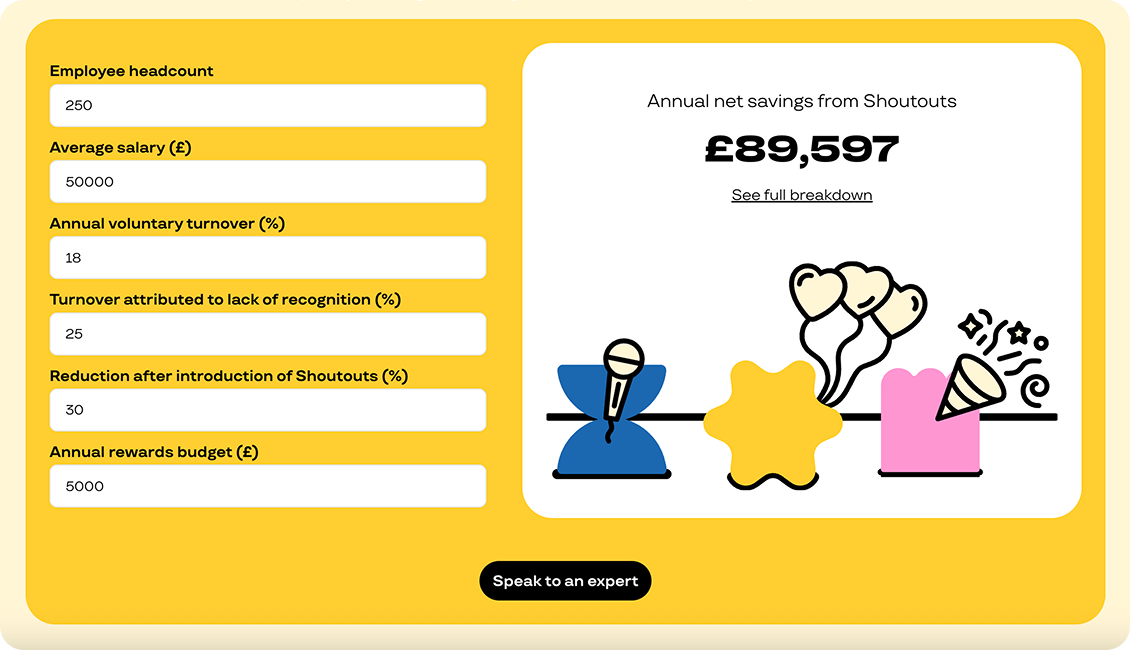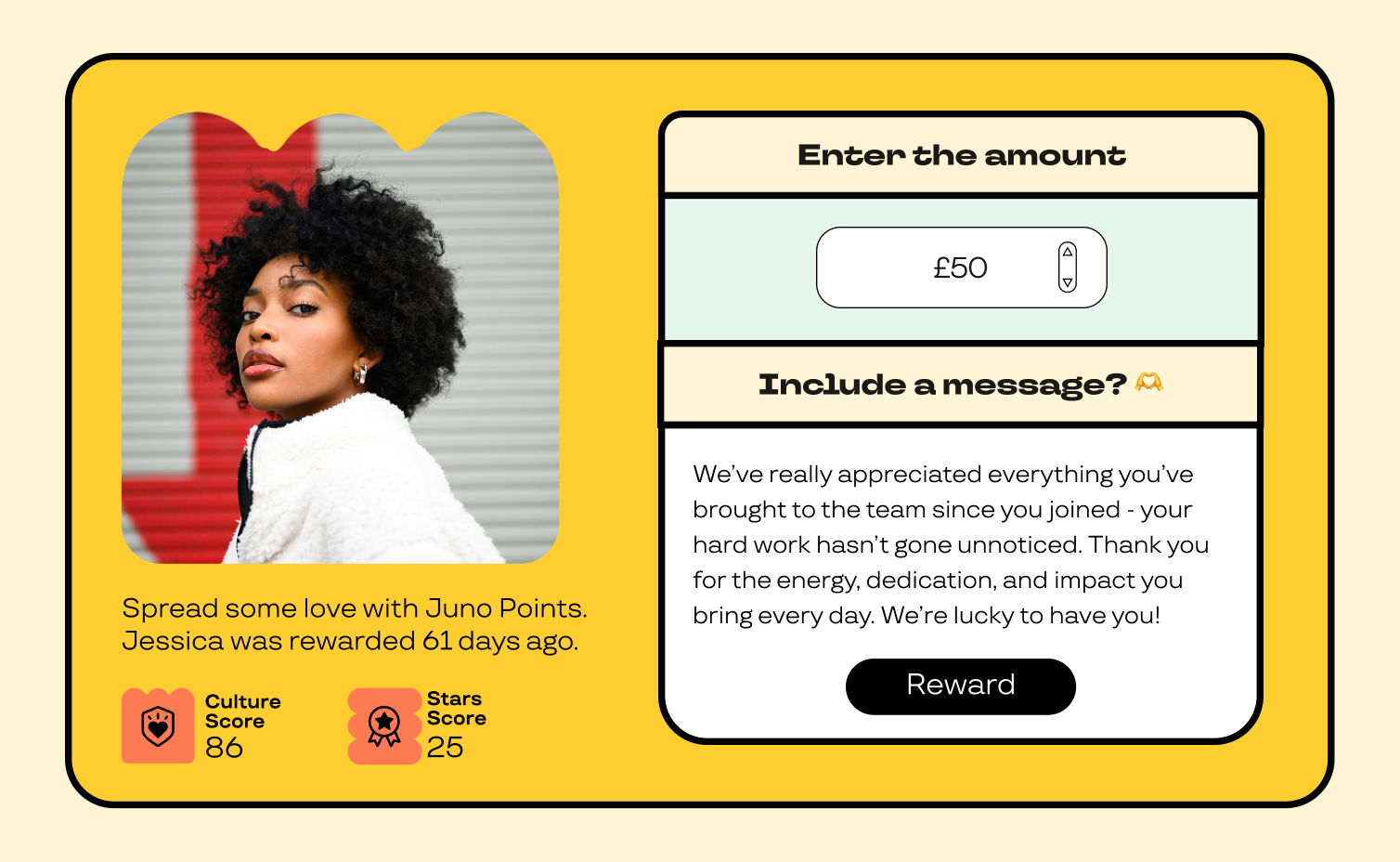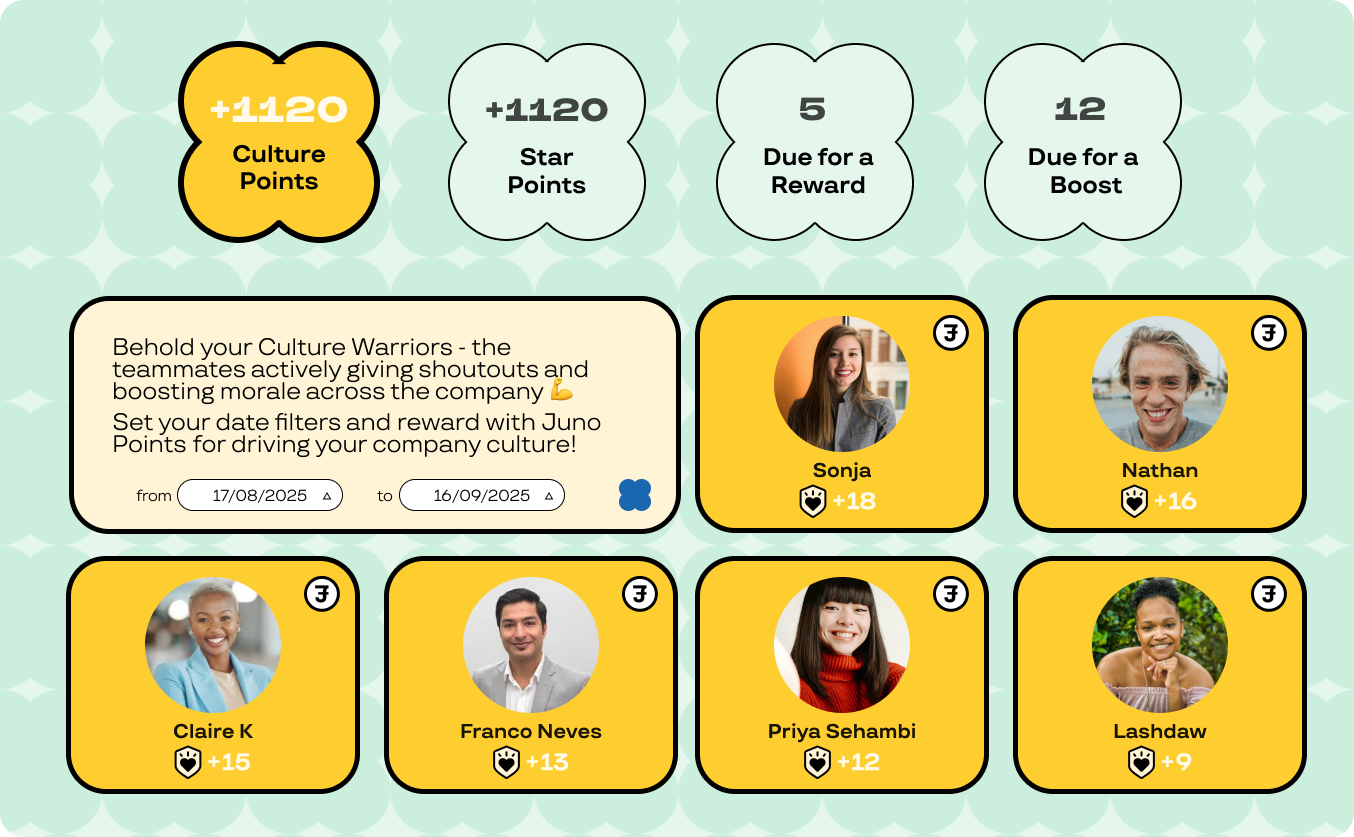
How to Maximise ROI From Your Recognition Budget in 2026
Introduction
By now, recognition isn’t up for debate, it’s an industry standard. Every serious business leader knows that consistent, meaningful recognition drives engagement, retention, and performance. The conversation has moved on from “Should we invest in recognition?” to “How do we make sure we’re doing it right….and seeing a return?”
That shift is crucial for 2026. With tighter budgets and higher employee expectations, businesses can’t afford recognition initiatives that feel tokenistic, inconsistent, or invisible. A poorly executed program doesn’t just waste budget - it risks undermining culture altogether.
The businesses that will see real ROI next year are those that treat recognition as a strategic investment, not a side project. They’ll use data, consistency, and the right tools to ensure every £/$/€ spent builds connection, loyalty, and impact across the organisation.
As we enter budgeting and renewals season, we’ll explore how to maximise the ROI of your recognition budget in 2026, and how to avoid the common pitfalls that hold small businesses back.
Define What ROI Means for Recognition
Before you can maximise ROI, you need to be clear on what “return” actually means for your business. Unlike marketing spend or sales activity, the impact of recognition isn’t always captured in a simple financial metric, but that doesn’t mean it can’t be measured.
For most organisations, ROI on recognition shows up in three main areas:
- Retention: Replacing an employee can cost anywhere from 30–150% of their salary. A culture of recognition reduces voluntary turnover by making employees feel valued and connected.
- Engagement & Productivity: Recognised employees are more motivated, more productive, and more likely to go above and beyond. That translates into higher output without increasing headcount.
- Culture & Employer Brand: Recognition builds a culture where people feel appreciated. This not only improves collaboration internally but makes it easier to attract new talent externally.
For many businesses who are struggling with retention, it can be difficult to nail down those reasons for turnover, but it’s essential to start gathering as much data as possible, as soon as you can.
In your exit interviews, be sure to draw out the real reasons for turnover - employees can often be hesitant to mention that they felt underappreciated, as it can come across as slightly childish. Asking this as a closed question, can help give you real actionable data - “did you feel appreciated by your colleagues? Yes or no?”.
Research suggests that 25% of turnover is due to lack of recognition, and that tackling this head-on can dramatically reduce this figure.
Make use of recognition calculators to understand the cost that turnover has on your business, and from there it becomes a lot simpler to understand what a successful recognition platform looks like when it comes to ROI.

If only one fewer member leaves your business as a direct result of your recognition platform, that’s going to save you north of £20k, almost certainly considerably more. Typical recognition platforms cost between £2k-£5k per year for every 100 members of staff, and so the ROI becomes monstrous.
The key is to treat recognition as an investment, not an expense. When you define what ROI looks like upfront, it becomes much easier to build a recognition program that delivers measurable results, and to defend that budget in boardroom discussions.
Shift From Ad-Hoc Rewards to Strategic Recognition
One of the biggest mistakes small businesses make is treating recognition as a series of random gestures - a coffee voucher here, a team lunch there, a “thank you” buried in an email. While well-intentioned, ad-hoc recognition is inconsistent, easy to overlook, and rarely delivers lasting impact.
To maximise ROI, recognition needs to move from sporadic rewards to a strategic, structured practice. That means:
- Consistency: Employees should know recognition is part of the culture, not a once-in-a-while surprise.
- Visibility: When recognition happens publicly, the impact multiplies. A single shoutout can inspire the entire team.
- Alignment: Recognition should reinforce company values and behaviours that drive business success — not just celebrate outcomes.
Where companies often go wrong is asking for votes in private - how often have we been asked to vote for our ‘employee of the month’ and provide reasons. Then HR/People will look through and decide in secret.
While this is all very well-intentioned, only the chosen winner gets to experience the rush of success and to understand what it is that made them number 1. All the other votes have no idea if they were recognised or not by their colleagues.
To maximise ROI, recognition should be in public, on display, where everyone can see it. That’s why using recognition platforms that are native to your existing comms platforms like Slack or MS Teams work best, and here’s why:
- No new tool fatigue means higher takeup and buy-in
- Existing natively where people already work means higher engagement, more recognition, more appreciation
- Your company vibe and culture comes across in Slack - every company has their own emojis, memes and inside jokes - latching on to that makes recognition feel natural and not forced
Strategic recognition doesn’t mean stripping out the fun or spontaneity. It means making recognition intentional, inclusive, and tied to your bigger goals. That way, every pound or minute you invest generates momentum rather than being quickly forgotten.
Create a Recognition Culture, Not Just a Rewards Program
Rewards programs are easy to launch - hand out gift cards, set up a quarterly bonus, or celebrate birthdays. But while rewards feel good in the moment, they don’t always create lasting cultural impact. To maximise ROI, you need to go deeper: build a recognition culture.
A recognition culture means that appreciation becomes part of daily life, not just a line item in the budget. It shifts recognition from being transactional (“Do this, get that”) to relational (“I see and value your contribution”).
Here’s why this matters for ROI:
- Scalability: Culture-driven recognition isn’t limited by budget. A heartfelt, public thank-you can be just as powerful as a £50 reward.
- Inclusivity: When everyone can recognise each other - not just managers recognising direct reports - participation skyrockets.
- Amplification: Public recognition doesn’t just boost the recipient’s morale. It sets an example, reinforces company values, and inspires others.
This is where the £50 gift card starts to become the cherry on top, but where public recognition is the real reward. This subtle shift means that you are maximising your ROI - recognition is free and massive.
When recognition becomes cultural, ROI isn’t limited to one employee’s motivation. The ripple effect lifts morale, strengthens collaboration, and creates an environment where people genuinely want to stay and perform.
Even though peer recognition is as powerful as manager recognition, the impact of a successful recognition platform can be driven by managers and execs. Being active daily, even if it’s just commenting in a thread, shows that this is important and encourages others to follow suit.
To maximise ROI, look for a tool that provides helpful analytics to show which team members are being shouted out frequently and which team members’ efforts could be going unnoticed. This data is invaluable when it comes to getting ahead of disengagement and potential turnover of staff.
Budget Smarter, Not Bigger
A common misconception among small business leaders is that recognition success depends on having a “big company budget.” The reality? ROI isn’t about how much you spend, but how you spend it.
Many businesses pour money into large, infrequent rewards - annual bonuses, expensive parties, or elaborate gifts. While appreciated in the moment, these gestures fade quickly and don’t build ongoing engagement. In contrast, smaller, more frequent recognition moments deliver stronger long-term returns.
Here’s how to budget smarter:
- Shift from lump sums to micro-moments: Instead of one large spend at year-end, allocate budget for weekly or monthly recognition touchpoints.
- Prioritise frequency and visibility: A £10 recognition that gets celebrated publicly may deliver more impact than a £100 gift card quietly given.
- Track engagement, not just spend: If only a handful of people are benefitting from your budget, ROI will stay low. Aim for broad participation.
Think of your recognition budget like an investment portfolio: diversify across different initiatives, spread it out over time, and monitor performance. By doing so, you’ll build momentum and ensure every pound contributes to culture - rather than being forgotten after a single spend.
Look for tools that keep rewards budget in the hands of admins and managers. Many tools put rewards into the hands of employees, which often leads to favour swapping where employees consistently reward their close teammates in exchange for being rewarded. This type of system creates a feeling of unfairness and can often become toxic very very quickly.
Tools that keep budgets in the hands of managers, and provide actionable and objective analytics as to which team members are most deserving of rewards removes the potential for bias, and also takes away the pressure of having to choose winners from HR and People leads.
Make sure that your tool allows rewarders to explain the reason behind the reward - this is incredibly powerful in both reinforcing the behaviour, but also in maximising the impact of the recognition.

Use Technology to Multiply Impact
Even with the best intentions, manual recognition programs often struggle. A manager might forget to follow through, recognition gets lost in private messages, or the effort required to track and report on activity becomes overwhelming. That’s where technology comes in.
The right recognition platform doesn’t just save time, it amplifies impact by making recognition more consistent, visible, and measurable.
Here’s how technology boosts ROI:
- Scalability: Recognition becomes easy for everyone, not just managers. Peer-to-peer tools empower teams to appreciate each other in real time.
- Visibility: Public recognition feeds, shoutout boards, or native integration with existing communication tools (like Slack or Teams) ensure wins don’t go unnoticed.
- Data & Reporting: Platforms allow you to track who’s recognising, how often, and which company values are being reinforced. This gives HR and leadership real evidence to demonstrate ROI.
- Inclusivity: Recognition no longer depends on budget-heavy rewards or manager approval - everyone can join in.
For many small businesses, Q4 is the moment to evaluate which tools will set them up for success in 2026. A modern recognition platform ensures you’re not just “doing recognition,” but doing it in a way that delivers measurable business results.
Measure, Review, Improve
Recognition isn’t a “set it and forget it” initiative. Like any other business investment, you need to measure performance, review outcomes, and adjust over time to maximise ROI. Too often, companies launch recognition programs with great fanfare - only to let them drift into inconsistency because no one is tracking impact.
Look for a tool that gives analytics around engagement:
- Participation rate: What percentage of employees are giving or receiving recognition each month?
- Frequency: How often are recognition moments happening? Once a quarter isn’t enough.
- Quality: Are shoutouts specific and meaningful, or generic and forgettable?
- Impact indicators: Track turnover, engagement survey scores, or customer satisfaction to see if recognition is influencing broader goals.
Review regularly
Schedule quarterly check-ins to analyse recognition data and gather feedback from employees. Look for trends - are certain teams more active than others? Do managers need more encouragement to model recognition behaviour?

Improve continuously
Use insights to refine your approach. For example, if participation is low, introduce prompts or campaigns to encourage recognition. If quality is lacking, provide examples of meaningful shoutouts.
Recognition works best when it evolves with your people and your business. By closing the loop - measure, review, improve - you ensure your recognition budget keeps generating results long after the initial launch.
Conclusion
In 2026, recognition doesn’t need to be about spending more - it’s about spending smarter. Small businesses that treat recognition as a strategic investment, not just a perk, will see measurable ROI in the form of higher retention, stronger engagement, and healthier workplace culture.
By defining what ROI means for your business, moving beyond ad-hoc rewards, embedding recognition into culture, budgeting intelligently, leveraging technology, and continually measuring and improving, you create a system where every pound of recognition budget generates impact.
The companies that succeed won’t be those with the biggest budgets - but those with the most consistent, meaningful, and visible recognition practices.
If you’re planning your Q4 initiatives and looking ahead to 2026, now is the right time to make recognition a priority. Platforms like Shoutouts by Juno are designed to help businesses build a culture of appreciation that’s simple, scalable, and proven to deliver ROI.
Because when recognition is done right, it doesn’t just reward employees - it transforms your business.

